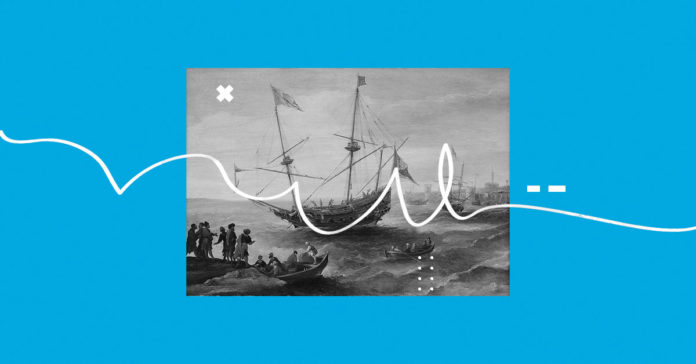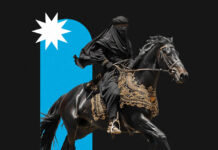Ancient America was not isolated from the old world as many historians and anthropologists would have us believe. People from both sides of the Atlantic ocean travelled great distances, mingled with each other and exchanged knowledge and products. Long before Columbus became aware of the possibility of land in the west, Muslims, among other people, had made contact with the Americas and had already left an impression on the Native culture.[1] Knowledge, agricultural products, livestock, metals, and other commercial items were exchanged between the two worlds. Evidence leading to establishing the presence of Muslims in ancient America comes from a number of sculptures, oral traditions, eye-witness reports, artifacts, Arabic documents, coins, and inscriptions. In Meso-American art, we see Africans and Semites in positions of power and prestige, especially in trading communities of Mexico.[2]
A report in Before Columbus by Cyrus Gordon describes coins found in the southern Caribbean region:
“…off the coast of Venezuela was discovered a hoard of Mediterranean coins with so many duplicates that it cannot well be a numismatist’s collection but rather a supply of cash. Nearly all the coins are Roman, from the reign of Augustus to the 4th century CE. Two of the coins however, are Arabic of the 8th century CE. It is the latter that gives us the terminus a quo (i.e. time after which) of the collection as a whole (which cannot be earlier than the latest coins in the collection). Roman coins continued in use as currency into the medieval times. A Moorish ship, perhaps from Spain or North Africa, seems to have crossed the Atlantic around 800 CE.[3]
The discovery of these coins adds validity to the reports, recorded by Muslim historians and geographers, concerning the journeys of Muslim adventurers and navigators across the Atlantic Ocean. In Muruj adh-Dhahab wa Ma’adin al-lawhar (The Meadows of Gold and Quarries of Jewels) written around the year 956 CE, Abul Hasan ‘Ali ibn al-Hussain ibn ‘Ali al-Masudi, a historian, geographer, philosopher, and natural scientist’, wrote about a young man of Cordoba named Khashkhash ibn Saeed ibn Aswad who crossed the Atlantic Ocean, made contact with people on the other side, and returned in the year 889 CE. Al-Masudi wrote:
“Some People feel that this ocean is the source of all oceans and in it there have been many strange happenings. We have reported some of them in our book Akhbar az-Zaman. Adventurers have penetrated it at the risk of their lives, some returning safely, others perishing in the attempt. One such man was an inhabitant of Andalusia named Khashkhash. He was a young man of Cordoba who gathered a group of young men and went on a voyage on this ocean. After a long time, he returned with a fabulous booty. Every Spaniard (Andalusian) knows his story.“[4]
A narration by Abu Bakr ibn ‘Umar al-Qutiyya (not to be confused with the author of Tarikh Iftitah al-Andalus, Ibn al-Qutiyya) relates the story of In Farrukh who landed in February 999 CE in Gando (Great Canary), visited King Guanariga and continued his journey westwards till he found islands he called Capraria and Pluitana. In May of that year he arrived back in Spain.[5]
Abu ‘Abd Allah Muhammad al-Idrisi (1099-1180), the famous Arab physician and geographer who established himself in the Arabicised court of King Roger Il of Sicily, reported in his extensive work, Kitab al-Mamalik wa-l-Masalik, in the 12th century, on the journey of a group of seamen who reached the isles of the Americas. Al-Idrisi wrote:
“A group of seafarers sailed into the sea of darkness and fog (the Atlantic Ocean) from Lisbon in order to discover what was in it and to what extent were its limits. They were a party of eight and they took a boat which was loaded with supplies to last them for months. They sailed for eleven days until they reached turbulent waters with great waves and little light. They thought that they would perish so they turned their boat southward and travelled for twelve days. They finally reached an island that had people and civilization but they were captured and chained for three days. On the fourth day, a translator came speaking the Arabic language! He translated for the King and asked them about their mission. They informed him about themselves, then they were returned to their confinement. When the westerly wind began to blow, they were put in a canoe, blindfolded, and brought to land after three days sailing. They were left on the shore with their hands tied behind their backs. When the next day came, another tribe appeared, freeing them and informing them that between them and their lands was a journey of two months.”[6]
This astonishing historical report not only describes contact between Muslim seamen and the Native people of the Americas, but it also describes travel between islands, probably the Bahamas chain or the Lesser Antilles. The islanders had developed the ability to speak Arabic, a language that cannot be mastered by a single contact. They must have been regularly visited by Arabic-speaking Muslim merchants or adventurers, or they had lived in Muslim territory.
In October, 1929 CE, Khalid Edhem Bey discovered by chance in the library of Serallo, in the city of Istanbul, a map of parchment made in the month of Muharram in the year 919 AH (March 1513). The rare and valuable geographical letter contained, among other legends, the following note:
“This chapter explains how this map has been made. Such a map nobody owns at present. By the hands of this poor man it has been composed and now elaborated.”
The discovery was very significant. As already stated, it had to do with a parchment in Turkish writing, painted in several colours, with dimensions 0.85 x 0.60.It comprises the Atlantic Ocean with America and the western rim of the world. The other parts of the world, which the map probably included, have been lost.[7]
The author of the map, Piri Muhyi’d-Din Re’ is was a famous navigator and map maker who died about 1554-55 CE. He wrote a handbook on navigation in the Aegean and the Mediterranean Seas, which was known as Piri Re’is Bahriye. Perhaps the map found by Khalil Edhem Bey was part of this handbook, which was presented to Sultan Selim I in 1517CE, and which would explain how the mysterious parchment was found in Serallo. What is most important to this study, however, is that this map is one of the most conclusive pieces of hard evidence to show the validity of Muslim exploration in the Western hemisphere. Piri Re’is, a Turkish navigator, wrote that he used twenty source-maps; among them eight maps dating from the time of Alexander the Great, an Arab map of India, tour Portuguese maps of the Indian Ocean and China, and a map by Columbus of the western area. But Pir’s map contains information that could not have been known by Columbus. It contains the correct relative longitude across Africa, and across the Atlantic, all the way from the meridian of Alexandria, Egypt, to Brazil. The mid-Atlantic islands are shown with remarkable accuracy. The Cape Verde islands, Madeira Islands, and the Azores are shown in perfect longitude. The Canary Islands are off by one degree longitude. The Andes are shown on this map in 1513 CE. The Andes were not “discovered” by Europeans until 1527 CE with the coming of Pizarro. The Atrato River (in present day Columbia) is shown for a distance of 300 miles from the sea. Its eastward bend at latitude 5 degrees north is correct. The Amazon is shown twice, once on the equator of the main grid and once on the equator of the small grid. The island of Marajo is shown at the mouth of the Amazon, but this island was not officially discovered by Europeans until 1543 CE. Someone must have travelled throughout the upper part of South America exploring rivers and recording information.[8]
The Haji Ahmed map of 1559 CE, also supports the validity of a Muslim presence in the Americas long before Columbus. He was also a Turkish map-maker who, in the tradition of Islamic scientists and technicians of his age, benefited from the knowledge of the ancient Egyptians, Hindus, Greeks, Romans, and Phoenicians, and took it to a higher level of development. Muslims had led the world in Astronomy, Astronomy, Mathematics, Chemistry, Medicine, History, Geography, Navigation, etc. for hundreds of years before the 16th Century, and Haji Ahmed followed in their footsteps. The Eastern Hemisphere, on his map, is poorly done and probably was based on the sources of Ptolemy. The Western side, however, was mapped so well that it is hard to believe that anyone could have drawn this map, who did not have access to maps of people well-travelled in the Americas. The shapes of North and South America are surprisingly modern, especially the western coasts. Their drawing on a highly sophisticated spherical projection puts the map about two centuries ahead of the cartography of that time.[9]
Another map of Florida, based on a French expedition of 1564, shows three names that demonstrate an earlier Muslim settlement in that area. They were written as follows:
Mayarca (Majorca)
Cadica (Cadiz)
Marracou (Marrakesh)[10]
How could these names have been used by people if they had not made contact with North African or Andalusian Muslims?
Anti-diffusionist scholars have countered earlier claims to a pre-Columbian presence in the Americas by casting doubt on the nautical ability of Muslim or African seamen, and by citing the difficulty of crossing the Atlantic Ocean. In 1969 CE, the Scandinavian scientist, Thor Heyerdahl crossed the Atlantic for the second time, starting from the North African port, Safi, and arriving in Barbados, West Indies. His craft was made by Africans of indigenous papyrus, thereby proving that not only could North African or West African sailors have crossed the Atlantic Ocean, but that even the ancient Egyptians could have done so. It is now well known that the currents coming off the Iberian Peninsula and western coastline of Africa will take a ship easily into the Caribbean or to the east coast of South America (present day Brazil).
[Deeper Roots: Muslims in the Americas and the Caribbean Before Columbus by Abdullah Hakim Quick, p. 14-19]
Notes:
[1] A number of linguists, historians, and archaeologists have postulated that Arabic-speaking North African Muslims had made contact with the Americas in the 7th century CE. They traced the journey of a North African explorer, using a number of Libyan/Kufic inscriptions, from the North African coast to the Red Sea, the Indian Ocean, the South China Sea, the Pacific Ocean, and into the Southwest of the present United States. Inscriptions in Libyan or Kufic in the Americas are also claimed to have been found. Much work is left to be done in order to verify these claims. Because of the tentative nature of this valuable area of research and the difficulty in tracing the primary documentation and materials, this chapter will focus on the Muslim exploration of the Atlantic side. For more information of the Pacific penetration see: Barry Fell, America B.C., (New York; Times Books, 1976); and idem, Saga America (New York: Times Books, 1980).
[2] Ford, Barbara, “Semites First in America”, Science Digest, January, 1972, 43-18; Clyde Ahmad Winters, Al-Ittihad, July-October, 1977.
[3] Cyrus Gordon, Before Columbus (New York: Crown Publishers Inc., 1971), 68-70.
[4] Al Masudi, Muruj adh-Dhahab, vol. 1, 138.
[5] A summary of this story was translated into Spanish by Don Manuel Osunay Savinon in Resumen de la Geografia Fisica y Politica y de la Historia Natural y Civil de las Islas Canarias, Santa Cruz detenerife, 1844, See Rafael Bazan, “Some Notes for a History of the relations between Latin America, the Arabs, and Islam in The Muslim World, vol. LXI, 291.
[6] Al -Idrisi, Geographia al-Idrisi (Dawzi Printing), 184 in Athar al-Madinatil Islamiyyah fl Hadratil Gharbiyyah by Dr. Mukhtar al-Qadi (Egypt: Pyramid Printing House, 1973), 335; or Al-ldrisi, Opus Geographicum vol. 5, 548.
[7] Rafael Bazan, The Muslim World, 284, 285.
[8] Joan Covey, “African Sea Kings in America? Evidence from Early Maps”, in Ivan Van Sertima, African Presence in Early America, 162, 163.
[9] Ibid., 164.
[10] Ibid., 166.18.









